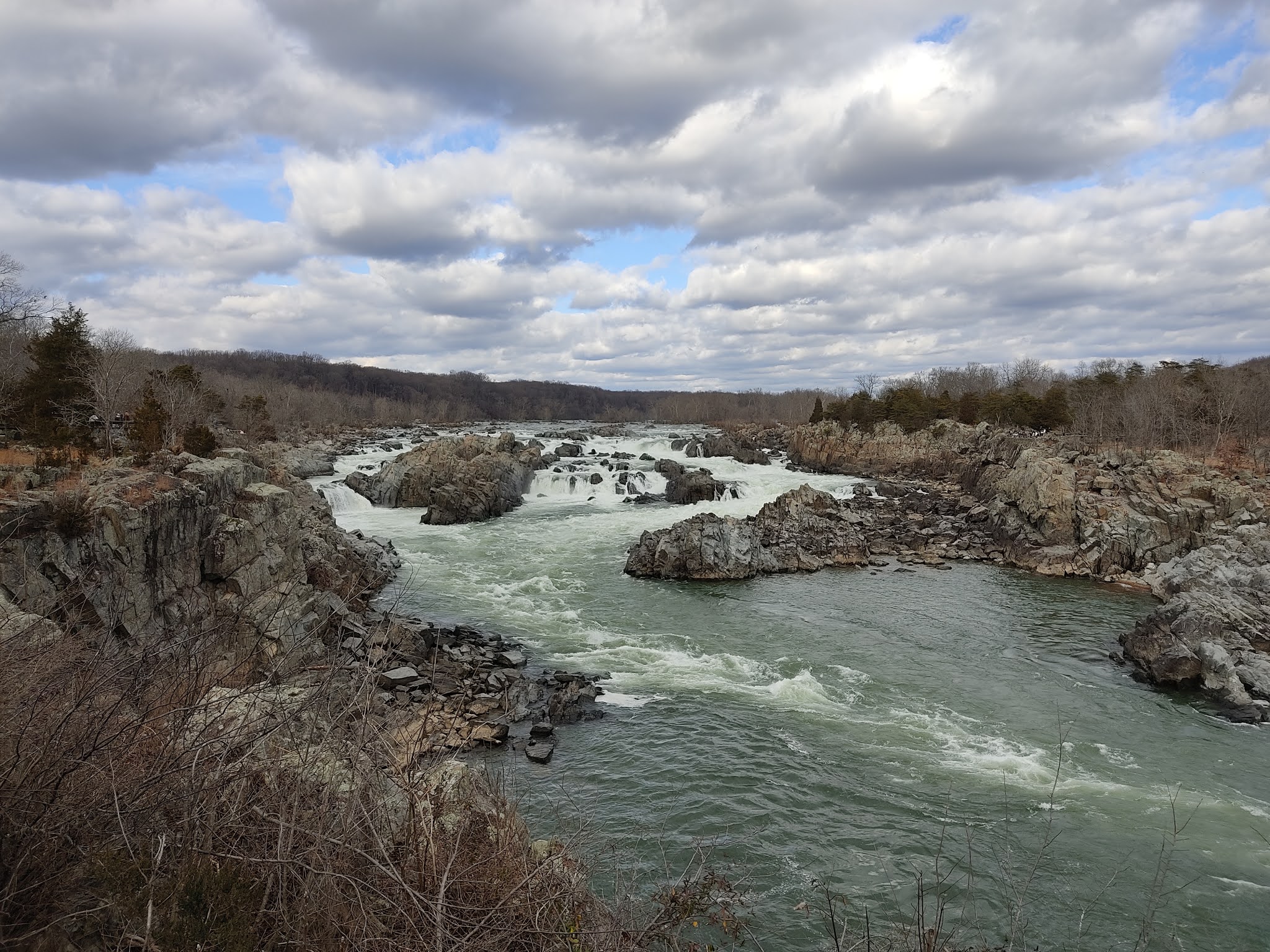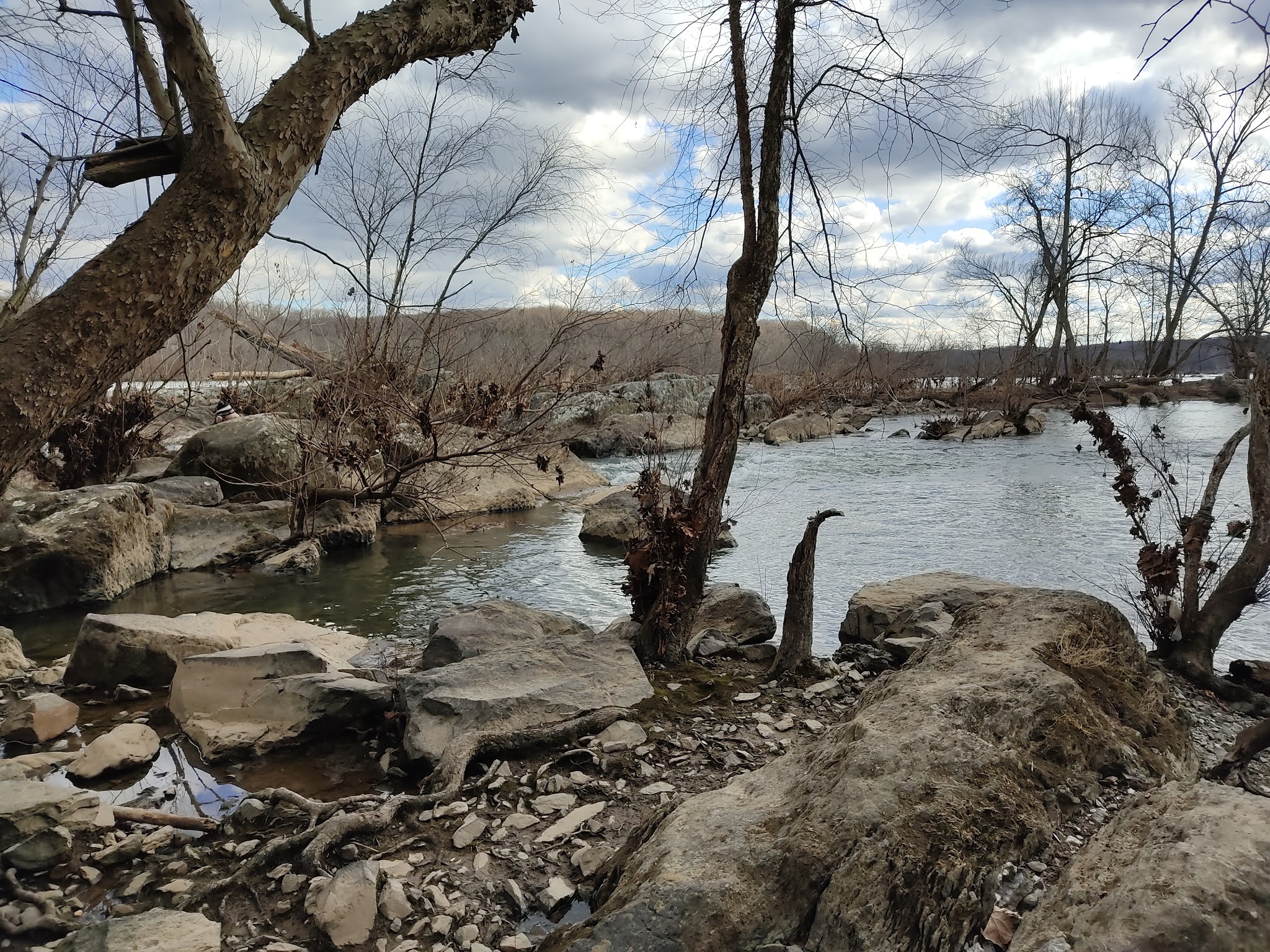La primera visita de nuestro viaje a Virginia y a sus alrededores fue al parque nacional Great Falls. Fuimos el domingo a mediodía, antes del feriado en honor a Martin Luther King Jr., por lo que, a diferencia de lo que muestran las fotos, había mucha gente. Muchísima gente. Exagerada cantidad de gente, en especial si se toma en cuenta que estamos en plena pandemia y que lo que queríamos era estar aislados y poder conectarnos con la naturaleza. Por suerte, el río Potomac, el mismo que atraviesa Washington D.C., es suficientemente impresionante para hacerte olvidar las familias, los niños, los perros, los adolescentes, los ricos montando a caballo y la gente sin mascarillas. Mientras caminábamos no dejé de pensar en Eustace Conway, ya que estaba leyendo su biografía escrita por Elizabeth Gilbert llamada “The Last American Man”.
Desde muy pequeño, el sueño de Conway era vivir en la naturaleza, a pesar de haber nacido en una familia americana urbana de clase media. Leyendo, visitando regularmente el museo de historia natural de su ciudad y constantemente experimentando aprendió todo lo necesario para ser autosuficiente en el bosque. Por muchos años se vestía con ropa que él mismo confeccionba a base de pieles de animales, construyó su propio tipi nativo americano – respetando escrupulosamente la tradición – y vivía en él, incluso durante sus años como estudiante universitario.
Creo que sería justo de calificar a Conway como un genio, en todo el
sentido de la palabra, que logra constantemente superar sus límites físicos y
mentales guiado por una autodisciplina casi militar y por un perfeccionismo enfermizo,
producto en gran parte de una infancia difícil y de su relación tormentosa con
su padre. Sin embargo, esa combinación le ha permitido desde muy joven realizar
hazañas dignas de récords, como recorrer los 3,500 km del Sendero de los
Apalaches en apenas cuatro meses y medio, o recorrer los Estados Unidos de este
a oeste en caballo en apenas dos meses.
Conway se opone totalmente a la sociedad moderna, a su forma de vida y
de trabajo, a su consumismo incesante y a su falta de sentido. Desde siempre,
su objetivo es mostrar el ejemplo para incitar a los estadounidenses a dejar
todo y regresar a la vida elemental en armonía con los seres vivos y las
estaciones, recuperando sus capacidades físicas y produciendo y elaborando uno
mismo lo necesario para vivir. Por eso se ha dedicado a recorrer el país dando
su testimonio en escuelas, festivales y en todo tipo de eventos donde es siempre
aclamado por su increíble carisma y su filosofía radical. Su obra maestra es Turtle
Island, una reserva que compró en Carolina del Norte cuando se dio cuenta que era
cada vez más difícil vivir en el bosque a causa de la urbanización. En Turtle
Island, Conway ha construido su propia comunidad y recibe aprendices que
quieren aprender a vivir como él y que lo ayudan a cultivar verduras, criar
animales y construir estructuras.
“The Last American Man” es el segundo libro que leo sobre personas de
nuestra época que quieren conectarse de nuevo con la naturaleza como una
alternativa a la alienación que nos ofrece la sociedad moderna, basada en el
trabajo, la familia y el gobierno. Lo que quiero investigar es si acaso es
posible una forma diferente de vivir y en qué condiciones. El primer libro que
leí fue “Into the Wild” de Jon Krakauer, sobre Christopher McCandless, un joven
que después de graduarse de la universidad dejó su vida acomodada de burgués
americano buscando lo fundamental de la existencia a través de sus viajes a lo
largo de los Estados Unidos, hasta que murió solo en Alaska en 1992.
Hasta ahora, las perspectivas no son muy optimistas. O se es solitario, ingenuo
e impulsivo como McCandless y se muere en el intento, o se tiene un proyecto
muy definido de crear una nueva sociedad, pero se termina en una alienación
comparable a la que se pretendía escapar desde un inicio. Eustace Conway puede
vivir en su reserva únicamente por que la compró, lo que significa que no es
posible liberarse del sistema capitalista ni siquiera para vivir en la naturaleza.
De hecho, al terminar el libro me enteré que desde el 2012 Conway es parte del reality
show “Mountain Men” del History Channel. Me cuesta encontrar algo más alejado
de la vida auténtica que él predica que participar en un reality show. Y no veo
cuál es el interés de vivir en su comunidad si él también aniquila al individuo
con su disciplina de vida extrema y su trabajo incesante.
¿Qué podemos hacer entonces? Por los momentos, no lo sé. Seguir leyendo,
me imagino, y seguir entrando en contacto con la naturaleza, aunque sea esa
naturaleza domesticada de los senderos y de los parques, donde ni siquiera se
pueden ver animales porque saben que los humanos están allí.
Our first visit on our trip to Virginia and its surrounding states was to the Great Falls National Park. We went on a Sunday afternoon, just before Martin Luther King Jr. Day so, despite what the pictures show, there was a lot of people. Tons of people. An exaggerated amount of people, especially if you consider that we are in the midst of a pandemic and what we wanted was to be isolated and to reconnect with nature. Luckily, the Potomac, the same river that reaches Washington D.C., is impressive enough to make you forget the families, the children, the dogs, the teenagers, the rich people riding horses and the people who did not wear masks. While we were hiking, I could not stop thinking about Eustace Conway, since I was reading his biography written by Elizabeth Gilbert entitled “The Last American Man”.
Since he was a child, Conway’s dream was to live in nature, even though he was born in a middle class urban American family. By reading, regularly visiting his hometown’s museum of natural history and constantly experimenting, he learned all that is necessary to be self-sufficient in the woods. For many years, he wore clothes he made by himself with animal skins, he built his own Native American teepee – which thoroughly respected tradition – and he lived in it, even during his time as a college student.
I think it would be fair to describe Conway as a genius, in all the
sense of the term, who constantly surpasses his physical and mental limits, guided
by an almost military self-discipline and by neurotic perfectionism, the product
in part of a difficult childhood and of his troubled relationship with his
father. However, this combination has allowed him to accomplish record-worthy
feats since he was young, such as hiking the entire 3,500 km of the Appalachian
Trail in just four months and a half, or horse riding from east to west of the
entire United States in barely two months.
Conway is totally opposed to modern society, to its form of life and
work, to its incessant consumerism and its lack of meaning. Since always, his
objective is to lead by example and encourage Americans to leave everything and to
come back to a more elemental way of life in harmony with all living beings and
seasons, to recover their physical abilities and to produce themselves all that
is necessary to live. That is why he has devoted his life to travel around the
country giving his testimony is schools, festivals and all sorts of events, in
which he is always acclaimed for his incredible charisma and radical
philosophy. His masterpiece is Turtle Island, a reserve he bought in North
Carolina once he realized that it was increasingly harder to live in the woods
because of urbanization. In Turtle Island, Conway has built his own community
and hosts apprentices who want to learn to live like him and who help him in
farming vegetables, raising animals and building structures.
“The Last American Man” is the second book I read on people of our time
who aim at reconnecting with nature as an alternative to the alienation of
modern society based on work, family and government. What I want to find out is
whether there is a different way to live and on what terms. The first book I
read was “Into the Wild” by Jon Krakauer, on Christopher McCandless, who after
graduating from college left his comfortable bourgeois American life in search of
the fundamental existence through his travels across the United States, until
he died alone in Alaska in 1992.
Until now, the perspectives are not very optimistic. Either you are
solitary, ingenuous and impulsive, like McCandless, and you die while trying,
or you have a well-defined project of a new society, but you end up in an
alienation comparable to the one you were looking to escape to begin with.
Eustace Conway can live in his reserve only because he bought it, which means
that it is not possible to free oneself from the capitalist system not even to
live in nature. In fact, once I finished the book I learned that Conway is part
of the reality show “Mountain Men” in the History Channel, since 2012. I am
having trouble finding something farther away to the authentic life he preaches
than to participate in a reality show. And I do not see the interest in living
in his community if he also annihilates the individual with his extreme life
discipline and incessant work.
What can we do then? For the moment, I don’t know. Keep reading, I guess,
and keep reaching out to nature, even to this domesticated nature of trails and
parks, where you cannot even see animals because they know humans hang there.








Post a Comment